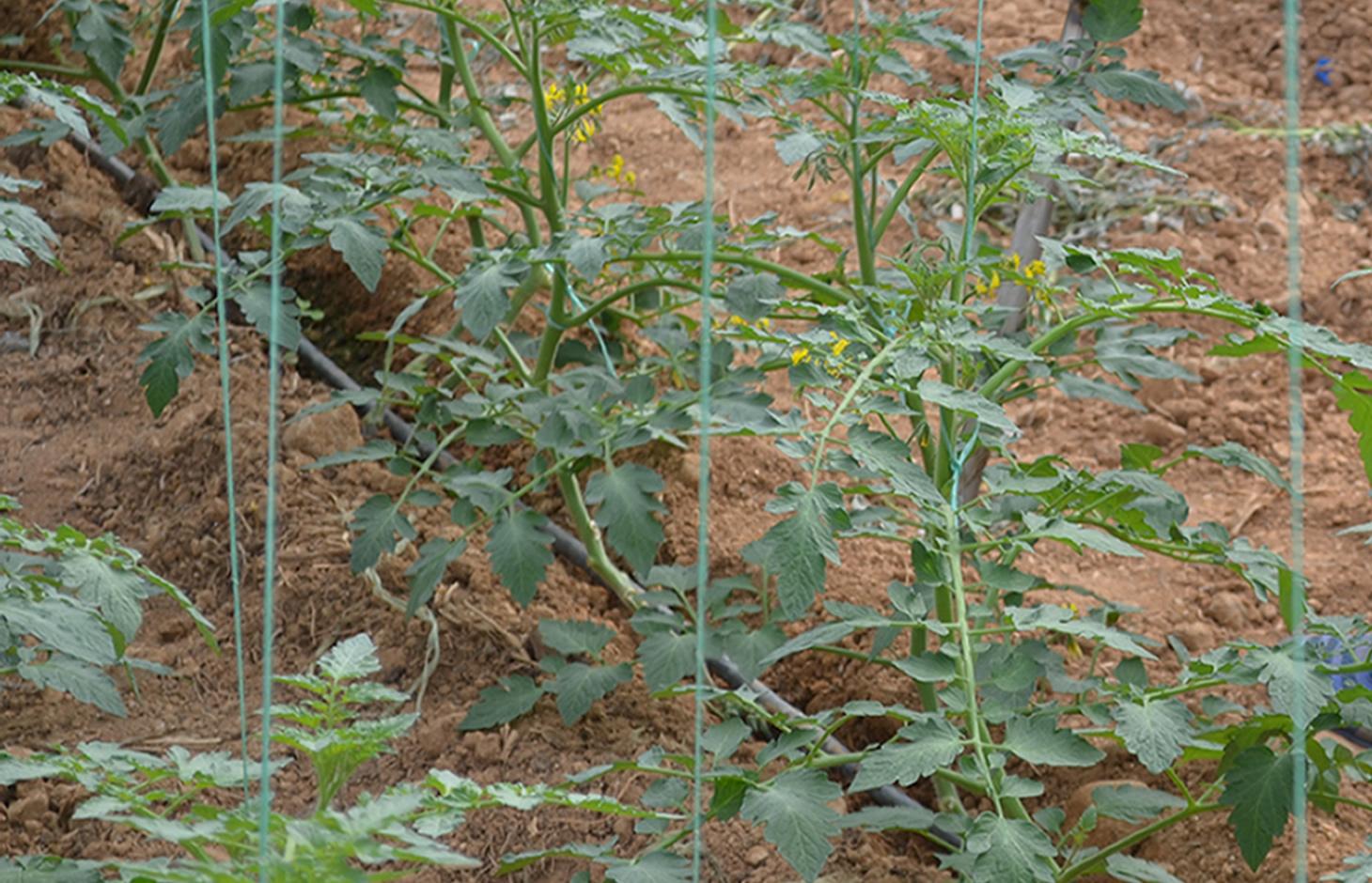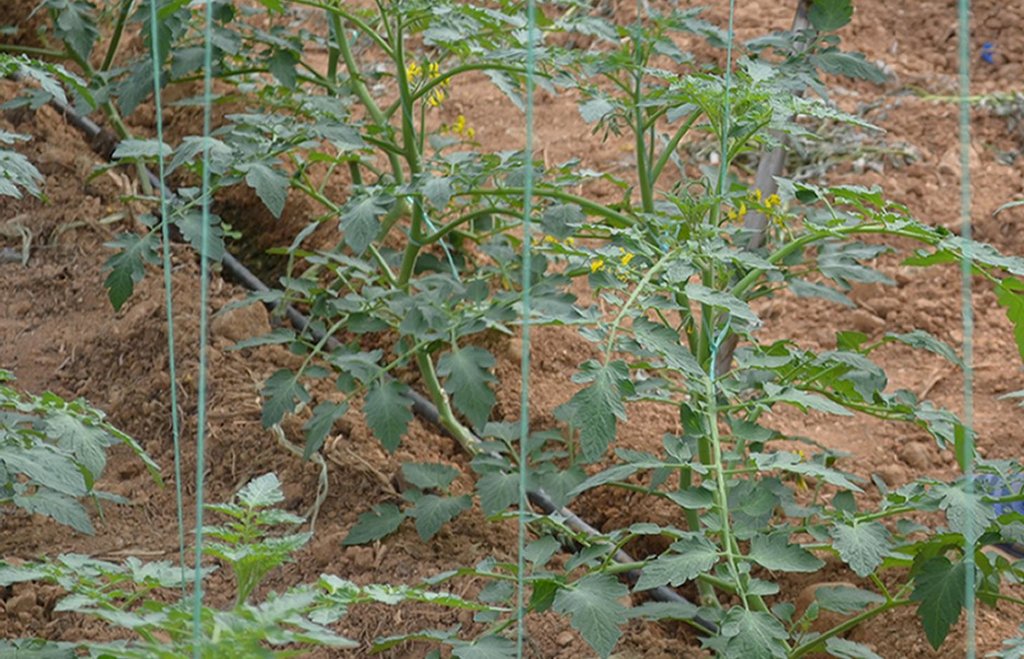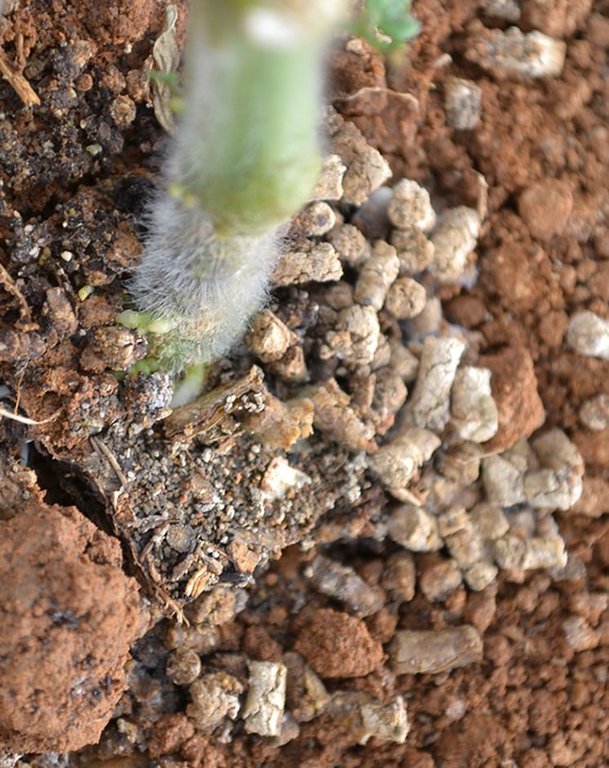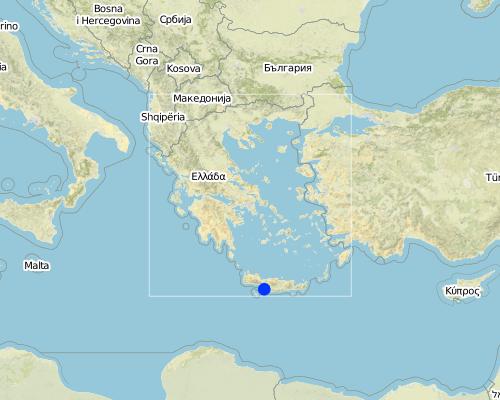Application of biological agents to increase crop resistance to salinity [希腊]
- 创建:
- 更新:
- 编制者: Ioanna Panagea
- 编辑者: –
- 审查者: Fabian Ottiger
Εφαρμογή βιολογικών παραγόντων για την αύξηση της αντοχής των φυτών στην αλατότητα του εδάφους
technologies_1281 - 希腊
查看章节
全部展开 全部收起1. 一般信息
1.2 参与该技术评估和文件编制的资源人员和机构的联系方式
SLM专业人员:
SLM专业人员:
有助于对技术进行记录/评估的项目名称(如相关)
Preventing and Remediating degradation of soils in Europe through Land Care (EU-RECARE )有助于对技术进行记录/评估的机构名称(如相关)
Technical University of Crete (Technical University of Crete) - 希腊1.3 关于使用通过WOCAT记录的数据的条件
(现场)数据是什么时候汇编的?:
08/03/2015
编制者和关键资源人员接受有关使用通过WOCAT记录数据的条件。:
是
2. SLM技术的说明
2.1 技术简介
技术定义:
Use of biological agents as plant salt tolerance facilitators and soil amendments.
2.2 技术的详细说明
说明:
The Trichoderma harzianum fungus and different various types of symbiotic associations of mycorrhizae are used in greenhouse cultivations in coastal Timpaki, Crete, Greece, in order to mitigate the impacts of salinity on crops and to improve the existing soil properties. These biological agents are supplied commercially as soil amendments, and specific treatments vary according to cultivation type.
Purpose of the Technology: The technology is applied as an effective agronomic measure for the increase of plants salt tolerance, the reduction of soil borne diseases that affect plant roots and increase of water and nutrients absorption. This technology prevents or mitigates soil degradation by improving the subsoil structure by causing plant root system expansion and increasing the ability of the plant to absorb nutrients and water. This effect can potentially decrease agricultural inputs (water and fertilizers) up to 40%. An additional benefit is the maintenance and increase of subsoil faunal diversity and the subsequent biodegradation. The improved soil structure leads to higher infiltration rates, mitigates salt accumulation in the root zone and combats soil salinity, one of the main soil degradation problems in the coastal zone. Finally, the application of the biological agent helps to keep the plants healthy thus leading to increased crop yield, and reduced production risk.
Establishment / maintenance activities and inputs: The implementation of such agents usually takes place once per plant as the microorganisms coexist with the plant (symbiotic association) and can be performed in different stages of the crop cultivation depending on the commercial product, e.g. as solution in the irrigation water, as solid soil amendment in the early growing stages, or optimally, to be applied in the plant nursery (seed bio-priming), or during planting (plant inoculation). Biological agents require increased organic matter in the soil, absence of toxic substances (e.g. copper, fungicides, and pesticides), and, depending on agent type, suitable soil moisture and temperature. Here we instigate the effects of biological agents in tomato plantations, which are implemented in the early growing stages through irrigation.
Natural / human environment: The average annual precipitation in the area is 500 mm and the climate ranges between sub-humid Mediterranean and semi-arid. Average annual temperature is 18.5 °C with 6 months below 18 °C but above 5 °C, thus classifying the area as subtropical. In the location where the technology is applied, land is mostly privately owned and water rights can be public, cooperative or private. The financial means of the land user applying this technology are more or less on par with those of the rest of the community, although he has wider empirical and theoretical education and higher impact acquired though his involvement in the local agricultural association as agronomist.
This Technology was documented within the scope of FP7 RECARE Project, grant agreement no 603498.
2.3 技术照片
2.5 已应用该技术的、本评估所涵盖的国家/地区/地点
国家:
希腊
区域/州/省:
Heraklion
有关地点的进一步说明:
Timpaki
Map
×2.6 实施日期
如果不知道确切的年份,请说明大概的日期:
- 10-50年前
2.7 技术介绍
详细说明该技术是如何引入的:
- 通过土地使用者的创新
注释(项目类型等):
The use of biological agents in agriculture is not new but it is also not part of the traditional cultivation system in the area, therefore the technology is not widely used.
3. SLM技术的分类
3.2 应用该技术的当前土地利用类型

农田
- 一年一作
主要农作物(经济作物及粮食作物):
Major cash crop: Tomato Solanum lycopersicum
注释:
Major land use problems (compiler’s opinion): The main problem in the region is the change in the groundwater quality, caused by the groundwater exploitation and and the subsequent seawater intrusion, resulting in soil salinisation through irrigation. The poor availability of non-saline water for irrigation results in increased production risk and agricultural inputs.
Major land use problems (land users’ perception): Reduced soil fertility and productivity, increase of soil salinity that affects productivity both short-term and long-term.
3.3 有关土地利用的更多信息
该技术所应用土地的供水:
- 充分灌溉
每年的生长季节数:
- 1
具体说明:
Longest growing period in days: 300Longest growing period from month to month: September to June
3.4 该技术所属的SLM组
- 病虫害综合管理(包括有机农业)
- soil amendments
3.5 技术传播
注释:
Total area covered by the SLM Technology is 0.002 m2.
3.6 包含该技术的可持续土地管理措施

农艺措施
- A2:有机质/土壤肥力
- A4:地表下处理
注释:
Main measures: agronomic measures
3.7 该技术强调的主要土地退化类型

化学性土壤退化
- Cn:肥力下降和有机质含量下降(非侵蚀所致)
- Cs:盐化/碱化

物理性土壤退化
- Pu:由于其他活动而导致生物生产功能的丧失

生物性退化
- Bq:数量/生物量减少
注释:
Main type of degradation addressed: Pu: loss of bio-productive function due to other activities, Bq: quantity / biomass decline
Secondary types of degradation addressed: Cn: fertility decline and reduced organic matter content, Cs: salinisation / alkalinisation
Main causes of degradation: soil management (Intensive cultivation), over abstraction / excessive withdrawal of water (for irrigation, industry, etc.) (Over-pumping), inputs and infrastructure: (roads, markets, distribution of water points, other, …) (Poor coverage of freshwater irrigation network.)
Secondary causes of degradation: crop management (annual, perennial, tree/shrub) (Monocultivation), droughts (Lack of sustainable water resources.)
3.8 防止、减少或恢复土地退化
具体数量名该技术与土地退化有关的目标:
- 防止土地退化
- 减少土地退化
注释:
Main goals: prevention of land degradation
Secondary goals: mitigation / reduction of land degradation
4. 技术规范、实施活动、投入和成本
4.2 技术规范/技术图纸说明
Technical knowledge required for field staff / advisors: high
Technical knowledge required for land users: low
Main technical functions: improvement of subsoil structure (hardpan), increase in nutrient availability (supply, recycling,…), increase of water and nutrients absorption rate by plants, plant root system expansion
Secondary technical functions: increase of infiltration
Agronomic measure: use of biological agents
Material/ species: Trichoderma harzianum or Mycorrhizae
Remarks: 25 gr/10 lt water is enough for 10 tomato plants
4.3 有关投入和成本计算的一般信息
其它/国家货币(具体说明):
Euro
注明美元与当地货币的汇率(如相关):1美元=:
0.91
4.4 技术建立活动
| 活动 | 措施类型 | 时间 | |
|---|---|---|---|
| 1. | biological agents in the form of powder and implementation through irrigation in each growing season | 农业学的 | in each growing season |
4.5 技术建立所需要的费用和投入
| 对投入进行具体说明 | 单位 | 数量 | 单位成本 | 每项投入的总成本 | 土地使用者承担的成本% | |
|---|---|---|---|---|---|---|
| 肥料和杀菌剂 | Biological agents (powder) | ha | 1.0 | 3232.0 | 3232.0 | 100.0 |
| 技术建立所需总成本 | 3232.0 | |||||
4.8 影响成本的最重要因素
描述影响成本的最决定性因素:
The only cost is the supply of the formulation with the biological agents which should be done before each growing season.
5. 自然和人文环境
5.1 气候
年降雨量
- < 250毫米
- 251-500毫米
- 501-750毫米
- 751-1,000毫米
- 1,001-1,500毫米
- 1,501-2,000毫米
- 2,001-3,000毫米
- 3,001-4,000毫米
- > 4,000毫米
农业气候带
- 半湿润
- 半干旱
Thermal climate class: subtropics. 6 months below 18 °C but above 5 °C
5.2 地形
平均坡度:
- 水平(0-2%)
- 缓降(3-5%)
- 平缓(6-10%)
- 滚坡(11-15%)
- 崎岖(16-30%)
- 陡峭(31-60%)
- 非常陡峭(>60%)
地形:
- 高原/平原
- 山脊
- 山坡
- 山地斜坡
- 麓坡
- 谷底
垂直分布带:
- 0-100 m a.s.l.
- 101-500 m a.s.l.
- 501-1,000 m a.s.l.
- 1,001-1,500 m a.s.l.
- 1,501-2,000 m a.s.l.
- 2,001-2,500 m a.s.l.
- 2,501-3,000 m a.s.l.
- 3,001-4,000 m a.s.l.
- > 4,000 m a.s.l.
5.3 土壤
平均土层深度:
- 非常浅(0-20厘米)
- 浅(21-50厘米)
- 中等深度(51-80厘米)
- 深(81-120厘米)
- 非常深(> 120厘米)
土壤质地(表土):
- 中粒(壤土、粉土)
表土有机质:
- 高(>3%)
如有可能,附上完整的土壤描述或具体说明可用的信息,例如土壤类型、土壤酸碱度、阳离子交换能力、氮、盐度等。:
Soil texture: Medium (characterized mainly as sandy clay loam or clay loam)
5.4 水资源可用性和质量
地表水的可用性:
中等
关于水质和水量的注释和进一步规范:
Ground water table: < 5 m, 5-50 m
Water quality (untreated): good drinking water, for agricultural use only (irrigation), unusable (brackish irrigation water)
5.5 生物多样性
物种多样性:
- 低
5.6 应用该技术的土地使用者的特征
生产系统的市场定位:
- 商业/市场
非农收入:
- 低于全部收入的10%
相对财富水平:
- 平均水平
- 丰富
个人或集体:
- 个人/家庭
机械化水平:
- 手工作业
- 机械化/电动
性别:
- 男人
说明土地使用者的其他有关特征:
Land users applying the Technology are mainly common / average land users
Population density: 10-50 persons/km2
Annual population growth: 1% - 2%
Level of mechanization: Manual labour and mechanised (automatic drip irrigation system)
Market orientation:
5.7 应用该技术的土地使用者拥有或租用的平均土地面积
- < 0.5 公顷
- 0.5-1 公顷
- 1-2 公顷
- 2-5公顷
- 5-15公顷
- 15-50公顷
- 50-100公顷
- 100-500公顷
- 500-1,000公顷
- 1,000-10,000公顷
- > 10,000公顷
这被认为是小规模、中规模还是大规模的(参照当地实际情况)?:
- 小规模的
5.8 土地所有权、土地使用权和水使用权
土地所有权:
- 个人,有命名
土地使用权:
- 租赁
- 个人
- cooperative
用水权:
- 社区(有组织)
- 个人
- cooperative
5.9 进入服务和基础设施的通道
健康:
- 贫瘠
- 适度的
- 好
教育:
- 贫瘠
- 适度的
- 好
技术援助:
- 贫瘠
- 适度的
- 好
就业(例如非农):
- 贫瘠
- 适度的
- 好
市场:
- 贫瘠
- 适度的
- 好
能源:
- 贫瘠
- 适度的
- 好
道路和交通:
- 贫瘠
- 适度的
- 好
饮用水和卫生设施:
- 贫瘠
- 适度的
- 好
金融服务:
- 贫瘠
- 适度的
- 好
6. 影响和结论性说明
6.1 该技术的现场影响
社会经济效应
生产
作物生产
生产故障风险
水资源可用性和质量
灌溉用水需求
收入和成本
农业投入费用
社会文化影响
Improved livelihoods and human well-being
生态影响
土壤
土壤水分
盐度
生物多样性:植被、动物
有益物种
害虫/疾病控制
其它生态影响
Increased soil biodiversity
6.3 技术对渐变气候以及与气候相关的极端情况/灾害的暴露和敏感性(土地使用者认为的极端情况/灾害)
渐变气候
渐变气候
| 季节 | 气候变化/极端天气的类型 | 该技术是如何应对的? | |
|---|---|---|---|
| 年温度 | 增加 | 不好 |
气候有关的极端情况(灾害)
气象灾害
| 该技术是如何应对的? | |
|---|---|
| 局地暴雨 | 好 |
气候灾害
| 该技术是如何应对的? | |
|---|---|
| 干旱 | 不好 |
注释:
The variety of biological agents is wide. A choice of thermophilic microorganisms is made in order for them to be able to withstand the high temperature conditions attained inside the greenhouse.
6.4 成本效益分析
技术收益与技术建立成本相比如何(从土地使用者的角度看)?
短期回报:
消极
长期回报:
非常积极
技术收益与技术维护成本/经常性成本相比如何(从土地使用者的角度看)?
短期回报:
非常积极
长期回报:
非常积极
6.5 技术采用
在所有采用这项技术的人当中,有多少人是自发地采用该技术,即未获得任何物质奖励/付款?:
- 90-100%
注释:
100% of land user families have adopted the Technology without any external material support
There is a strong trend towards spontaneous adoption of the Technology
Comments on adoption trend: 15% of the local farmers have already applied the technology. As the level of knowledge and farming expertise in the area increases and word of mouth makes the good results of the technology known, more farmers apply it.
6.7 该技术的优点/长处/机会
| 土地使用者眼中的长处/优势/机会 |
|---|
|
Simple to implement and little additional workload. How can they be sustained / enhanced? Introduction of pre-inoculated plants. |
|
Reduced net costs of agricultural inputs. How can they be sustained / enhanced? Keep soil free of heavy metals and pesticides that limit biological agents so that they can function as intended. |
| 编制者或其他关键资源人员认为的长处/优势/机会 |
|---|
|
The technology greatly improves soil functions and crop production. How can they be sustained / enhanced? Keep soil free of heavy metals and pesticides that limit biological agents so that they can function as intended. |
|
There is a wide variety of biological agents and their application can be tailored to the specific needs of each cultivation. How can they be sustained / enhanced? Research on specific applications for local cultivations and conditions in order to achieve optimal results |
6.8 技术的弱点/缺点/风险及其克服方法
| 土地使用者认为的弱点/缺点/风险 | 如何克服它们? |
|---|---|
| High initial cost. | Biological agents can be purchased in bulk quantities by the local farmer's union to reduce costs. |
链接和模块
全部展开 全部收起链接
无链接
模块
无模块





